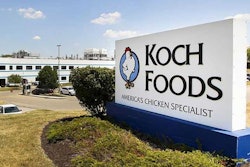
Extreme winter weather in February will further squeeze chicken supplies.
In a WATT Poultry Chat interview, Mark Jordan, executive director of LEAP Market Analytics, said extreme weather in the southeastern United States caused problems for chicken growers and processors that led to a significant decline in slaughter in late February. He said this will likely have a lingering impact on total chicken supplies.
Austin Alonzo: I understand you want to discuss what the impacts were on the poultry industry and in other markets, due to the particularly harsh winter we had in January and February.
Mark Jordan: You know, you can't always escape Mother Nature. And sometimes we get some events that are especially problematic. And this was one, if you go back to that week of I guess February 14 to February 20. Some really intense cold weather, cold air, a lot of snowfall, a little bit of ice, really plunged down through the Midwest hard. It came down into Texas, Arkansas, Oklahoma, and then spread east, south and east from there. There were issues in Louisiana, Mississippi, Tennessee, and even further east, out into the Mid Atlantic. So (there were) widespread issues.
Now, a lot of the snowfall and cold temps really made some for some bad issues in Texas. I know that that made national headlines in terms of the power issues there. And the broiler industry really took a beating from that storm. I've got a chart here just to kind of highlight the slaughter impacts. The U.S. Department of Agriculture reported slaughter during that week, about 96 million, which is about 70 million birds off of what would be normal. Now those are not all necessarily all losses to mortality, there were some losses, there more just from a displacement standpoint. Harvest got delayed, and we already have seen in the last week or two the USDA reports on slaughter show that we're making up some of that backlog.
So the industry's getting some of those birds back but there's been a huge displacement, tens of millions of birds, and there have been and there are going to be some pretty severe losses. Also looking at chick placements. During those couple of weeks, the week of the storm the week after it looked like about 6 or 7 million chicks didn't get placed on grow out farms that should have been available. And so those are losses, it'll kind of have a lingering impact.
So you've got an issue here. The only real comparison here in modern times are somewhat recent memories. Hurricane Katrina went back and looked at some numbers there in late August, early September of 2005. And you can see a pretty big disruption there, of course, is that the hurricanes swept up the Mississippi Gulf Coast, into Mississippi, and Alabama and a lot of losses there. But there were scores of chicken houses that suffered, roof collapses, a lot of issues that hatcheries and plants getting everything kind of back cleaned up and the power running and things like that. So definitely some big issues.
Austin Alonzo: Mark, did you have anything else to add about this topic?
Mark Jordan: Yeah, this is certainly going to take a chunk out of first quarter supplies. Looking at per capita availability, we see a little bit of a dip. We've been running at pretty high levels, a lot of chicken has been out there in the market. And some of the production impacts: We're going to take enough offline here in February and March to take take domestic availability, at least in my preliminary calculations of production also thinking about population effects and net trade flows, we're going to take the domestic supplies down on a per capita basis, in my estimation, a good 5 to maybe 6% from year ago. Now, a year ago was really big compared to the first quarter of 2019. But still, when you look back over where we've been in the last year and a half to two years, this is a bit tighter supply situation than then the market, you know, and then years have been getting used to it. We've already seen some fairly aggressive run up in chicken breasts and chicken wing prices. So, at a time we're really needing some supply, we're going to be squeezed a little bit.
So the good news is I think the the industry is going to be motivated to come back I think we see a pretty good supply bounce by mid- to late spring that really kind of picks up steam maybe in the summer. So there should be a good supply come back from this but this is definitely going to be an issue near term in terms of limitations.
Transcript edited for length and clarity.
















